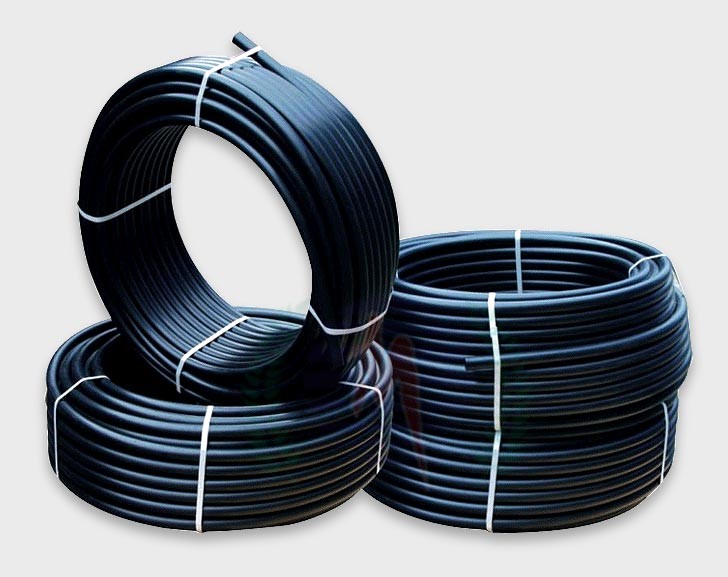Strengths of Choosing custom hdpe pipe manufacturing Midland TX for Unique Requirements
Check Out the Manufacturing Process Behind High-Quality HDPE Pipe and Its Applications
The production procedure of premium HDPE pipelines is complex and systematic. It begins with the choice of basic materials that improve efficiency. Following this, ethylene undertakes polymerization to create material, which is after that formed via extrusion. Quality control is vital, ensuring that the end product satisfies rigid standards. The journey of HDPE pipes doesn't finish with manufacturing. Their applications throughout various markets disclose a broader importance worth analyzing.
Comprehending HDPE: Properties and Advantages

High-density polyethylene (HDPE) is a flexible polycarbonate recognized for its resilience and resistance to different environmental aspects. This product shows superb tensile strength, making it appropriate for requiring applications. Its low-density structure adds to a lightweight product, assisting in convenience of handling and installment. HDPE additionally showcases exceptional resistance to chemicals, which lessens destruction when subjected to rough materials.
The material's low wetness absorption better improves its longevity, making it suitable for usage in pipelines and tank. Additionally, HDPE is immune to ultraviolet (UV) radiation, making certain that products keep their honesty also when subjected to sunlight. Its versatility permits for the creation of elaborate shapes without jeopardizing toughness. The green nature of HDPE, commonly stemmed from recycled products, includes in its allure, advertising sustainable methods in manufacturing. Generally, these residential properties and benefits make HDPE a recommended selection for numerous commercial and customer applications.
Basic Material Selection for HDPE Production
The option of resources for HDPE production is necessary to validate the last item satisfies the preferred requirements and quality standards. High-density polyethylene (HDPE) is largely generated from polymerized ethylene, stemmed from nonrenewable fuel sources such as natural gas or unrefined oil. The high quality of these feedstocks significantly influences the mechanical and thermal properties of the last HDPE.
Additives likewise play a substantial role in improving HDPE's efficiency, consisting of anti-oxidants, UV stabilizers, and colorants, which enhance durability and resistance to environmental variables. The option procedure should think about not only the chemical structure of the raw products however also their handling attributes to guarantee reliable manufacturing.
The sourcing of raw products ought to focus on sustainability and conformity with environmental regulations, as accountable techniques are crucial in today's market. Ultimately, careful resources option lays the foundation for generating top notch HDPE pipes ideal for diverse applications.
The Extrusion Refine: Shaping HDPE Pipeline
The extrusion procedure plays an essential role in forming HDPE pipes, starting with careful material prep work techniques that assure excellent circulation and consistency. Equally important is the design of the die, which directly influences the final measurements and surface area top quality of the pipe. Together, these factors contribute substantially to the effectiveness and quality of HDPE pipeline manufacturing.
Material Preparation Strategies
Efficient production of HDPE pipes starts with meticulous material preparation methods, especially the extrusion procedure. Throughout this phase, high-density polyethylene material is very first dried to get rid of wetness, making certain optimal circulation features. The material is after that fed right into the extruder, where it goes through home heating and melting, changing right into a thick state. This home heating procedure is very carefully regulated to keep the product's integrity and performance. The liquified HDPE is compelled via a die, forming it right into a continual pipeline kind. Correct temperature level management during extrusion is important, as it directly influences the product's homes and the end product top quality. Once formed, the HDPE pipe is cooled down and reduced to specified sizes, ready for succeeding processing and applications.
Die Layout Importance
Precision in die style plays a crucial function in the extrusion process of HDPE pipelines. The die works as the final shaping device, directly influencing the pipeline's measurements, wall surface thickness, and surface area finish. A well-designed die assurances uniform material circulation, lowering flaws such as irregularities and vulnerable points. The geometry of the die must be optimized to accommodate the particular residential properties of HDPE, including its thickness and thermal actions throughout extrusion. Additionally, the cooling price of the product as it passes with the die can considerably affect the pipeline's structural stability. Consequently, spending in advanced die technology is essential for makers aiming to generate high-quality HDPE pipelines that satisfy market criteria and customer expectations.
Quality Assurance Procedures in HDPE Production
Although different variables influence the top quality of HDPE pipe manufacturing, reliable quality assurance actions are vital to assure consistency and integrity in the end product. Key high quality control practices include rigorous product inspection, confirming that the raw polyethylene meets established criteria for pureness and thickness. During the extrusion process, specifications such as temperature, stress, and cooling time are carefully checked to keep dimensional accuracy and structural integrity
On top of that, post-production screening is necessary; suppliers commonly perform hydrostatic examinations to examine the pipeline's strength and resistance to pressure. Aesthetic assessments for surface defects better improve quality control. Qualification from appropriate standards organizations, like ASTM or ISO, gives an added layer of integrity. By implementing these extensive high quality control procedures, manufacturers can decrease flaws, improve efficiency, and make certain that the HDPE pipelines fulfill the certain needs of different applications, inevitably bring about consumer satisfaction and depend on in the item.
Applications of HDPE Pipe Throughout Industries
HDPE pipelines are used across numerous fields as a result of their longevity and convenience. In water distribution systems, they ensure effective shipment, while in wastewater monitoring, they offer dependable remedies for waste transportation. Additionally, farming watering networks profit from HDPE's resistance to corrosion and adaptability, making it an optimal option for modern farming methods.

Water Circulation Equipments
A considerable variety of markets rely upon high-density polyethylene (HDPE) pipes for reliable water circulation systems. Known for their longevity and resistance to rust, HDPE pipelines are widely made use of in local supply of water networks, agricultural watering, and industrial applications. Their lightweight nature promotes easy handling and setup, minimizing labor prices and time. Additionally, HDPE pipes can suit numerous pressure degrees, making them ideal for both reduced and high-pressure systems. custom hdpe pipe manufacturing Midland TX. The adaptability of the product permits seamless assimilation into existing framework, decreasing the requirement for comprehensive excavation. HDPE's resistance to chemical leaching warranties that the water delivered continues to be risk-free and tidy, making it an excellent selection for preserving the high quality of potable water throughout numerous sectors.
Wastewater Administration Solutions
Effective water circulation systems also lead the means for innovative wastewater administration remedies, where high-density polyethylene (HDPE) pipes play a significant function. Distinguished for their sturdiness and resistance to deterioration, HDPE pipes are suitable for carrying wastewater in various setups. Their versatility enables very easy setup in intricate settings, reducing the requirement for comprehensive excavation. Furthermore, HDPE's smooth indoor surface lowers friction, boosting flow rates and effectiveness. These pipelines are also resistant to chemical leaching, making certain that contaminants do not jeopardize the surrounding setting. Industries, districts, and treatment centers progressively rely on HDPE pipes for their dependability and long life, making them a recommended option for contemporary wastewater administration systems. This adaptability emphasizes the essential importance of HDPE pipelines across various applications.
Agricultural Irrigation Networks
Agricultural irrigation networks benefit greatly from making use of high-density polyethylene (HDPE) pipelines, which supply effective and trustworthy water shipment to crops. HDPE pipes are light-weight, making them very easy to move and mount, while their versatility permits for different arrangements in diverse terrains. These pipes show outstanding resistance to deterioration, chemicals, and UV radiation, making certain sturdiness in harsh agricultural settings. In addition, their smooth indoor surface area decreases rubbing loss, maximizing water flow and minimizing power prices related to pumping. The durability of HDPE pipes, usually exceeding 50 years, adds to reduce maintenance and replacement expenditures. Farmers significantly rely on HDPE pipelines to enhance watering performance and promote sustainable agricultural techniques, eventually leading to boosted crop yields and resource conservation.

Future Fads in HDPE Pipe Modern Technology
As the demand for sustainable and reliable framework expands, innovations in HDPE pipe modern technology are positioned to transform different industries. Arising patterns consist of the combination of smart innovations, such as sensing units and IoT abilities, which help with real-time tracking of pipe problems, reducing upkeep expenses and stopping leaks. In addition, the development of sophisticated manufacturing strategies, such as 3D printing, is enabling the manufacturing of complicated, tailored pipeline styles that satisfy details project needs.
The focus on recycling and round economic situation methods is driving the advancement of HDPE pipelines made from recycled products, boosting sustainability. Enhanced jointing methods, such as electro-fusion and mechanical installations, are likewise improving setup performance and reliability. Ultimately, the growing focus on ecological laws is pressing producers to take on greener production processes, making sure that HDPE pipes not just fulfill sector criteria however also cultivate a more lasting future for facilities growth.
Often Asked Concerns
Exactly How Does HDPE Contrast to Other Plastic Products?
HDPE outperforms lots of other plastic products concerning longevity, chemical resistance, and adaptability. Its low density and high tensile toughness make it ideal for numerous applications, frequently going beyond choices in both efficiency and durability.
What Are the Environmental Influences of HDPE Manufacturing?
The ecological influences of HDPE manufacturing include greenhouse gas discharges, power usage, and prospective contamination from making procedures. Furthermore, incorrect disposal can result in dirt and water contamination, elevating problems about lasting eco-friendly impacts.
Can HDPE Pipeline Be Recycled?
Yes, HDPE pipes can be reused. Many centers accept made use of HDPE for handling, changing it into brand-new items. This reusing adds to sustainability efforts, reducing plastic waste while conserving sources and power in the production cycle.
What Is the Life-span of HDPE Pipeline?

How Do Temperature Level Variations Influence HDPE Pipeline Performance?
Temperature variations substantially influence HDPE pipe performance, affecting versatility and toughness. Heats can lead to softening, while low temperatures may create brittleness, ultimately influencing website the pipeline's durability and suitability for numerous applications in diverse settings.